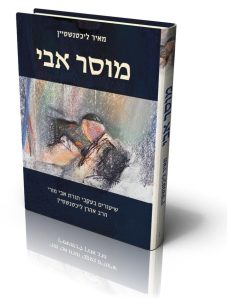Alt+SHIFT: Musar Avi

Yitzchak Blau makes an encore appearance with this special summer supplement to his popular Alt+SHIFT series—that’s the keyboard shortcut allowing us quick transition between input languages on our keyboards. For many readers of TRADITION that’s the move from Hebrew to English (and back again). It offers R. Blau’s insider look into trends, ideas, and writings in the Israeli Religious Zionist world, helping readers from the Anglo sphere to gain insight into worthwhile material available only in Hebrew. See the archive of all past columns in this series.
 Mayer Lichtenstein, Musar Avi: Shiurim Be’ikvei Torat Avi Mori HaRav Aharon Lichtenstein zt”l
Mayer Lichtenstein, Musar Avi: Shiurim Be’ikvei Torat Avi Mori HaRav Aharon Lichtenstein zt”l
In commemoration of R. Aharon Lichtenstein’s tenth yahrzeit, his son, R. Mayer Lichtenstein, published Musar Avi, a volume of written adaptations of his annual yahrzeit shiurim delivered over the past decade, alongside two eulogies and five letters from father to son. Each of the shiurim dialogues with one of R. Aharon’s foundational essays. R. Mayer, a Ram in Yeshivat Orot Shaul and the Rav of a shul in Beit Shemesh, manages to convey his father’s character, analyze his father’s Torah, and add his own insights.
R. Mayer captures some of the most outstanding traits of his illustrious father. Despite his powerful ethic of not wasting time, R. Lichtenstein never interrupted someone else speaking. At meetings of Roshei Yeshivot Hesder, while others perused a sefer, R. Lichtenstein listened carefully to his colleagues and took notes. Speaking as someone who struggles with impatience and does interrupt others, I found this element particularly inspiring and instructive.
R. Lichtenstein’s mode of thought included the ability to see different sides of an issue. R. Mayer relates a story from former Israeli Supreme Court Justice Neal Handel in which R. Lichtenstein was asked whether or not yeshivot should give tests. After outlining five reasons to do so, he explained his opposition to the idea. Another tale captures his exceptional breadth of knowledge. During a shiur on Massekhet Shabbat, R. Lichtenstein listed ten areas of halakha where we need to define cooking. I suspect that most talmidei hakhamim would come up with four or five (Shabbat, milk and meat, korban Pesach, and mevushal wine—ask yourself how many others you can name off the top of your head).
This volume does a good job of describing Brisker Talmudic analysis. These conceptual frameworks preceded R. Hayyim Soloveitchik, but he provided a terminology for this analytic enterprise. Terminology is not only a pragmatic boon; it enhances the thinking process itself. For example, several Aharonim attempt to determine if the mitzva of shofar consists of blowing it or in hearing its sound; Talmudic evidence exists in both directions. R. Hayyim explained that the ma’aseh ha-mitzva (the action) is in the blowing but the kiyyum (the actual fulfillment) is in the listening. R. Mayer notes how Avnei Nezer offers a parallel idea but that he struggles in explicating the essence of the idea due to his lacking the relevant terminology.
In an extremely clever passage, R. Mayer conveys the difference between the bekiut based pilpul of the Beit Halevi and the more analytic approach of his son, R. Hayyim. Each one had a story in which someone who did not recognize them mistreated them and then tried to apologize after realizing just who they had insulted. Both Solovetichiks criticized those apologizing for thinking that only significant people deserve respect. The Beit Halevi made the point with a source. Hazal praise Abraham’s hospitality more than Lot’s because our patriarch thought he was hosting mere mortals while his nephew knew he was taking care of angels. R. Hayyim made the same point in a purely analytic fashion. “You did not insult the Brisker Rav [i.e., R. Hayyim]. You insulted one who you thought to be a simple Jew. Go find him and apologize.”
One essay addresses his father’s innovative idea of seeing Hesder, the combination of Torah study and army service, as an ideal and not as a second-rate option for those who cannot learn full time [read the English translation of this chapter at TraditionOnline.org]. Both R. Lichtenstein and his long-time partner, R. Yehuda Amital, shared this vision but each articulated in his own characteristic fashion. R. Amital told his well-known story about hearing the crying baby whereas R. Lichtenstein wrote an extended essay analyzing the many dimensions of the question.
R. Mayer correctly notes that the Hesder essay is polemicizing against Yeshivat Mercaz HaRav which encouraged a much shorter army service. Indeed, in a talk at Yeshivat Otniel, he pointed out how his father’s presence helped break the communal hegemony of R. Tzvi Yehuda Kook and created another model within the Religious Zionist community. This theme returns in the chapter on R. Lichtenstein’s essay on the nature of bitahon. He thought that some of the crisis following the Yom Kippur war came from an overly optimistic Kookian viewpoint which cannot imagine any retreats in the redemptive process.
Not surprisingly, several essays address issues of ethics in Jewish thought, a topic very dear to his father. One interesting section distinguishes between Rambam and R. Lichtenstein regarding two areas where Rambam suggests that the pious go beyond the letter of the law: giving charity to the gentile poor and treating a Canaanite slave with the utmost respect. According to R. Mayer’s analysis, Rambam taught that two categories of ethical obligations exist: a Torat Avraham applying on a universal plane and a Torat Moshe restricted to the covenantal Jewish people. In contrast, R. Lichtenstein, a religious humanist, believed in the validity of a human ethic going back to the beginning of history, preceding either Torah. He also notes how, in one passage, Rambam portrays non-Jews as cruel (Avadim 9:8) whereas R Lichtenstein emphasizes their spiritual potential and accomplishments.
The discussion of bitahon surveys several models including those who think we can dispatch with effort or hishtadlut (the Alter from Novordok), those who think we need hishtadlut but that it does not actually produce results (Hazon Ish), and those who think our efforts directly make an impact (R. Soloveitchik and R. Lichtenstein). I leave many other good sections for readers to discover for themselves. This book is worthwhile for those who wish to experience R. Aharon Lichtenstein’s teachings, and benefit from the wisdom and musar of the father zt”l as well as that of his son.
Yitzchak Blau, Rosh Yeshivat Orayta in Jerusalem’s Old City, is an Associate Editor of TRADITION.
